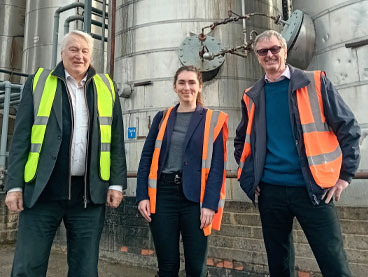Mark Townsend from UFAC-UK explains how immune system responses can hit milk yields.
Immune system glucose demand will hit yields
Mark Townsend from UFAC-UK explains how immune system responses can hit milk yields.
Glucose is the major energy source for a dairy cow and is a vital nutrient for milk production as it is essential for the production of lactose which is the key driver of milk yield. For example, a cow producing 40 litres of milk at 4.6% lactose will require 2.64kg glucose per day just for milk production.
But glucose is also an essential component of the cow’s immune system. When a cow faces an immune challenge such as mastitis or metritis, she will immediately divert extra glucose to the immune system. She can’t stop this happening and what actually happens is glucose is diverted from milk production so yield will fall. This can be a particular problem at calving and while cows get established into lactation for two reasons. The first is that intakes are suppressed meaning that cows can be short of glucose anyway.
The second is that at this time cows will face a raised immune challenge and increased glucose demand. It has been shown that all cows will experience some degree of inflammation and heightened immune response for several days after calving.
Huge immune demand
When immune activity is increased, cows can move an additional 90g glucose per hour to fight infection, which adds up to over 2.00 kg/day. The impact on yield can therefore be considerable.
Research shows that cows with high immune response post-calving are more likely to have significant negative energy balance, so steps should be taken to minimise the impact.
The key is to ensure adequate glucose is provided in transition and fresh cow diets to allow an efficient immune system while not compromising milk yield. To achieve this, diets should contain high levels of glucose precursors, particularly glycerol, that can be used efficiently by the cow.
UFAC UK’s Glycerene is a source of glycerol which is utilised efficiently by the liver to give cows a glucose boost. Being rumen inert, it passes quickly to the intestine where it is absorbed. It is a better source of glycerol than propylene glycol because it is utilised more efficiently by the cow and because it is rumen inert.
Focussing on glucose supply in the transition and early lactation period will help get cows settled into milk production, reduce negative energy balance and help them cope with the immune challenges around calving.
The importance of transition cow management
David Turnbull from UFAC-UK looks at the importance of effective transition cow nutrition.
Transition management is all about:
Providing the foundations for a productive lactation including the cow getting back in calf again,
Adapting the rumen to feeds of higher density rations and maximise DMI post calving to minimise negative energy balance (NEB),
To reduce metabolic disease, and
To produce a healthy calf.
The transition period is where up to 80% of disease costs occur. The risks are considerable when one considers milk fever, retained cleansings, metritis, early lactation mastitis, ketosis and acidosis.
The transition diet needs to address a wide range of issues. Most importantly we need to ensure transition cows are free from rumen disruption so that the diet can be used effectively and intakes built up so that the cow mobilizes less fat and muscle from body reserves.
Stimulate DMI
Feed Intakes are key. Maximum body tissue loss in response to NEB occurs in the period 2 weeks pre to 5 weeks post calving. Losses are approximately 70% fat & 30% protein. Research shows that feeding dietary non-fibre carbohydrate, highly digestible forages and protein during the transition period stimulates DMI. As DMI is also affected by management and environmental factors, it is essential transition cows are well looked after. Looking at the diet, the key nutrients are glucose, amino acids, fatty acids and minerals so diets should be carefully evaluated for each of these. Glucose and amino acids are the major fuel supply for the developing foetus, mammary gland and milk protein synthesis.
Don’t forget amino acids
With regard to protein, the pre-calving transition diet needs to be a minimum 14% CP, ideally 15%. Firstly, it is essential to maximise microbial protein yield as this is the most economic source of protein. Then we need to ensure DUP is at least 30% of the total diet CP content as amino acids are a major contributor to glucose production.
Specifically, methionine is one of the 10 essential amino acids that must be fed because the cow cannot produce it. It is required for normal liver function and to reduce the incidence of fatty livers. Methionine has beneficial effects on rumen fermentation and microbial protein synthesis, energy balance and immune system and can boost fertility, milk yield, protein and fat.
Regarding the balance of fatty acids, PUFA are also required, in particular omega 3’s from marine oils. These boost the immune system along with vitamin E, Selenium, copper and zinc. Also marine oils boost egg quality and size post calving thus help to improve conception rates.
UFAC UK’s Promega Plus including methionine and marine oil, the modern fish meal replacer for ruminants and Glycerene are specifically designed for this period and early lactation as a good DUP and energy source without any disruption to the rumen function. importance of transition cow management


 Back to News
Back to News 



